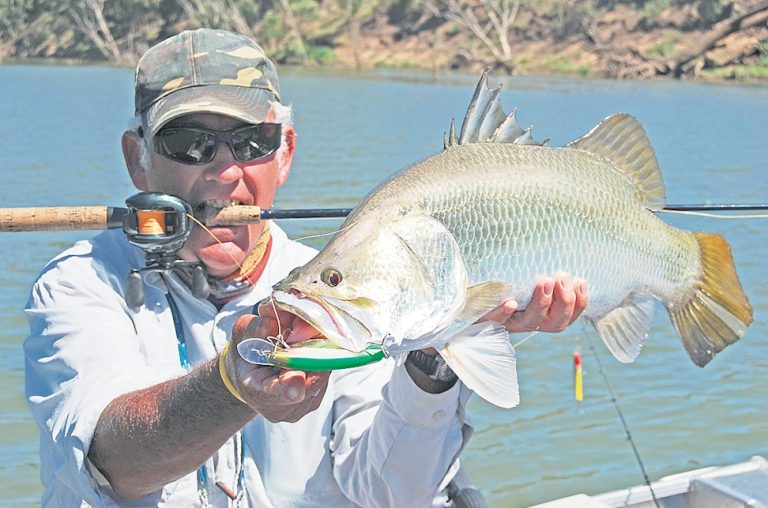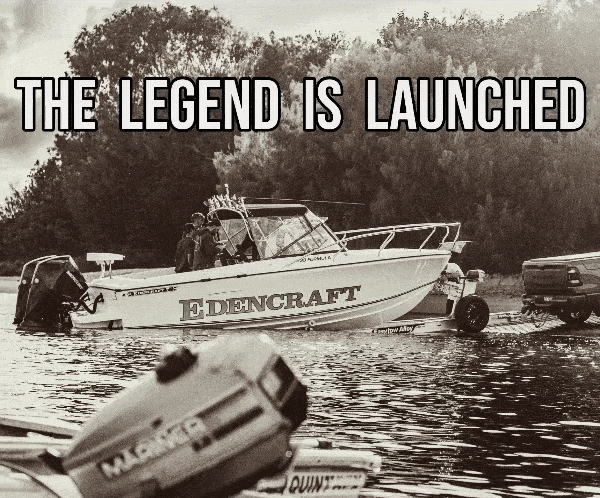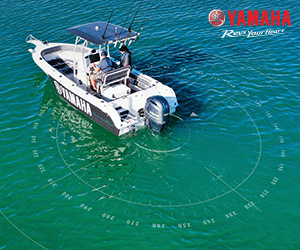Where barra go when the rain comes – Bill Bowtell 2013
“Understanding the movements of barra during flood events will help the angler to more consistent catches”. I read these words more than thirty years ago and they ring true to this day.
Several years ago when I was working up in the central Gulf Country on the Gregory River I left my run a bit late to get out of the area. Dirt roads and early storms further up the catchment around Riversleigh and the eastern escarpment of the Barkly Tablelands saw me trapped north of the Gregory Downs pub on Planet Downs station as the Gregory came down. I sat out an anxious few weeks waiting for a break in the weather so that my survey crew could move our camp of nine months, back to the storage area in Cloncurry. The river rose, sat stable for a week, then fell. We moved, but not before having the opportunity to witness the effects of the build-up to the “wet” and what it meant to the fish.
Having lived and camped on the banks of the Gregory for nine months saw the river play a major role in all forms of activities. The foremost being water supply, followed closely by recreation: fishing, canoeing and swimming. A close affinity grew up between us and the river.
The first hint of a change in the mood of the picturesque and tranquil Gregory River came during early October at a period of the full moon. The waterhole on which we were camped had at its head a series of rapids where three “runners” merged into one to form a section of scoured banks, submerged snags and aerated water. It was a good spot to fish, especially for barra, at both early morning and late afternoon. During the heat of the day the fish would push back into the hole proper and sulk under the undercut banks and over hanging pandanus and ti-trees. It was very rare to see free swimming fish in open water during these times. This changed…
As the weather warmed and humidity rose, the fish, primarily barra, became more active and for longer periods. Fish could be seen milling around the snags at the bottom of the “runners” and even cruising well into the day at the edges of the shadows cast by the riverside trees. They knew that something was about to happen. The “something” being events that would dictate their movement and life-cycle and ultimately the survival of the species.
The second hint was the sound of distant thunder far off to the south, south-west as heat storms built up on the eastern escarpment of the Barkly Tablelands. These, almost daily, events finally giving away to spasmodic, but heavy, short-lived, downpours. The barra became active and congregated in numbers around structure and weed-beds. They were agitated (and easy to catch) attacking just about everything that was tossed at them. Then it rained. Not local rain, but heavy and prolonged storms in the upper catchment. The river began to move.
The first indication that things were “on-the-move” came when I walked down to the river from camp to check my cherabin pots. I had three of these set along the hole, from just below the rapids to the end of the first stretch of weed bed. They produced some succulent feeds, as well as top barra baits. Just out from the weeds fish were lined-up and all facing upstream. There were all kind of species, but barra were dominant. They were not feeding, but just moving and sharing each other’s company. I sat and watched.
The second indication came within the next half hour. At first it was just the faintest of colour changes – a slight opaqueness in the near crystal water – then a rise in the noise level of the upstream rapids. Then came the small sticks, the leaves, the broken pieces of cow and wallaby dung, dirt, dust and crushed grasses, all pushed ahead of a rapidly advancing wall of brown, frothy water. The fish reacted swiftly.
Perched above in the middle branches of an old, ancient she-oak I had full view of events as they unfolded beneath me. Some barra moved quickly and, in schools of 5 – 8 fish, shot off downstream ahead of the advancing waters. Others paired off according to size and moved to the side of the river to where there were pockets of clear water in the eddies and backwaters caused by the shape and line of the bank. These fish were mainly big, mature fish, and they remained stationary to the point that they only moved when they felt it time to go. They then shot out into the current and were gone. It was most spectacular, and remains vividly etched in my mind to this day. It was more than two months with a continuous run in the Gregory before another barra was caught by my crew. It was a chrome-sided beauty – yellow tailed, albeit a little tattered. It had come upstream.
Events such as these play out each year right across the range of the barramundi and it is worthwhile for the fisher to understand some of these basic traits. For they not only build up an appreciation of the fish itself, but they give the angler a better chance to identify when and where the fish might be at particular times of the year according to weather conditions.
Since moving from the Gulf country, more than twenty years ago, back to the east coast’s central region, based around Yeppoon and Rockhampton, there have been numerous opportunities and occasions to witness firsthand similar events as those experienced whilst at the Gregory River. None more so than what has occurred during the past five years – in particular the events of 2012-2013.
It is well recorded now that the 2008-09 wet season in the Fitzroy catchment was a major flood event. Science estimates that in some areas of the catchment, especially the Comet and Nogoa rivers and Theresa Creek systems, this flooding equated to a 1 in 100 year event. Major floods in the other systems that feed the Fitzroy saw the entire system flow at its highest level since the massive 1991 event – a 1 in 85 year flood – that inundated parts of the city of Rockhampton for more than a month and the floodplain for up to three months. That the river again flowed at major flood levels in the 2009-10 wet season was most significant – especially on the breeding cycle and recruitment of barramundi.
Prior to the “wet” of 2008-09 Central Queensland had been in a prolonged and protracted drought of more than 10 years. Waterholes, dams, weirs and impoundments were at all-time record lows and there was no replenishment of major migratory species of fish such as barramundi into upstream areas of the Fitzroy River beyond the Rockhampton barrage. The only recruitment of barra into the freshwater was through the efforts of local fish stocking groups. Concerns were being expressed by some regarding the continued fishing pressure being exerted on stocks below the barrage – especially the netting effort – considering the need to conserve big breeding female and mature male barra for when conditions were again conducive to mass and multiple spawning. With the floods of 2008-09 and 2009-10 (especially) nature lent a hand.
Following age-old instincts, those fish, artificially introduced into the up-stream areas of the Fitzroy river through restocking programs, made their way downstream with the floodwaters just as if they had been born in the system. Sightings of fish seen going over the walls of weirs and spillways were recorded. Tales from farmers and graziers along the river told of mature fish held up in pockets of clear water and in backwaters as the waters rose, only to be gone in the next instance – déjà’ vu of the Gregory years before!
These fish went with the flow and entered the saline section of the Fitzroy en masse. At first it was carnage as every vantage point in the river beyond the restricted zone had a commercially set net in place. Reliable sources within the industry were shocked at the wastage when there was just too much product for the market to handle and yet the fishing continued. The saving grace came when the river broke its banks and the fish spread across the flood plain. At this time the barra had one thing on their mind – to breed whilst the salinity levels were still high enough ahead of the fresh run-off – and this occurred at known points around the mouth of the river in the Delta. Results of sampling done throughout 2009 and 2010, following two extremely good wet seasons, showed that recruitment was at an all-time high, with juvenile fish in their thousands showing up at every sample site. Nature and the barra had done their best. And it got even better.
With the initial movement of barra during any flood event being downstream, how then do fish again show up in the upper reaches following, an even during, flood events? The observant fisher will note the difference. Here two major factors come into play: one, length of time the waterway remains in flood and accessible to migrating fish and, two, the year class and size of fish which push upstream. A general rule is that mature fish push down to the saline reaches to breed whilst juvenile and immature fish push upstream to grow-out to maturity. There are exceptions and because they are exceptions, they are varied.
Female barra can, and often do, have multiple spawnings in the one season. They will develop their roe, but for one reason or another only have a partial drop. They will then stay in the area resting and feeding until the time, and phase, of the moon is again right, then spawn again.
This can take place over a partial phase of the lunar cycle (new/full moon), or over a full lunar cycle of one month. This time lapse is critical to the movement and distribution of barra within a river system. And is most important to the fisher, for it determines where and when the barra will show up (if at all) in those flood dependant stretches of creeks, rivers and floodplain lagoons.
Many rivers and streams do not flood to maximum accessible water heights for extended time periods. In days gone by this really did not matter, as even a moderate flood would allow passage of fish upstream and out across the floodplain. In the modern era, however, with the building of dams, weirs and barrages and the advent of ponded pasture walls being constructed adjacent to river systems and coastal floodplains, this restricted water flow does have a major impact on fish movement and the distribution of fish such as barra. Combine this with the spawning period and cycle of the barra and a picture begins to emerge.
Here the fisher needs to consider two primary points : one, the timing of the local spawning season, and two, the timing of the flood event.
Here in Central Queensland there is sufficient evidence to show that spawning of barra occurs from October through to March, with October and November being the peak periods. It is known that if the Fitzroy system receives early storms during this period and there is a slight run in the river then the recruitment will be high. The fry push into the brackish tidal swamps where they begin their grow-out phase.
The wet season in Central Queensland starts after Christmas and progresses through to April/May with late January, February and early March the peak rainfall periods with general flood rain events. This is a generalisation, as there are always exceptions to the rule. It is this period of flooding which distributes the barra, both large and small, and is most important to the fisher targeting this species.
If the recruitment from the October and November spawnings is high but subsequent flood flows are of a short duration and of minor height, distribution will be primarily confined to the estuary and lower floodplain creek and lagoon systems. Under these circumstances mortality of fish is generally high as lagoons dry, creeks shallow and fish become contained within the estuary where they have to compete from a very early age.
If, however, flood events are long and protracted and of a major height level there not only will be the possibility of multiple spawings, but the distribution of barra will be widespread and will most likely involve migration into those upper freshwater reaches – even by mature fish!
Over the years of chasing and observing barra I have caught many mature fish well upstream of weirs, barrages, ponded pastures and natural barriers such as waterfalls, which show obvious signs of having spawned. These fish have flayed and tattered tails from fighting the floodwaters yet are hollow-bellied with distended gonads. They were chrome sided beauties who just wanted to “go home”.
This year’s flood event in the Fitzroy released a lot of fish from the upper freshwater reaches. The river did not stay up for long (nine days at the time of writing this). There was early recruitment. It will be interesting to see how the estuary and freshwater scenes play out.





